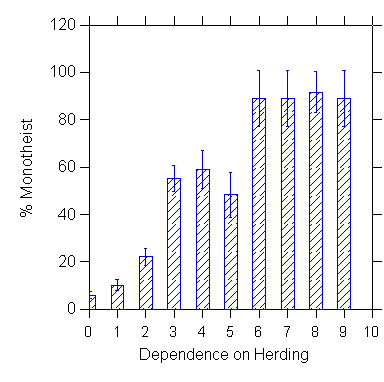Module 12 (HS8) - ENVIRONMENTALLY SPECIALIZED
SOCIETAL TYPES
0. OBJECTIVES
In this module you will learn the distinctive
characteristics of 3 types of environmentally specialized societies:
-
fishing societies
-
maritime societies
-
herding societies
1. INTRODUCTION
These societies (fishing, maritime, and herding
societies) are specialized to a specific environment. As such
they are outside of the "main sequence" of socio-cultural evolution (H&G
-> horticultural -> agrarian -> industrial) within the ecological-evolutionary
typology of human societies:
2. FISHING SOCIETIES
EX: Kwakiutl of British Columbia (home of the
potlatch)
Fishing societies rarely evolved into more
advanced societies, because:
-
fish population not easily depleted with traditional
technology => no need to switch to horticulture (compare with the scenario
of emergence of horticulture in which societies with H&G technology
were forced to find a new subsistence because of depletion of animal resources)
-
territory is hard to defend (typically a thin
coastal strip) => fishing society often conquered and absorbed into more
powerful horticultural or agrarian society
3. MARITIME SOCIETIES
EX:
-
Minoan civilization (Crete, ca. 2300-1450 BC)
-
Phoenicia (Lebanon, ca. 1100-146 BC)
-
Carthage (near Tunis, ca. 850-146 BC)
-
Ancient Greece, particularly Athens (1100-338
BC, date of victory of Philip of Macedony over Athens and Thebes)
-
Venice (peak 1204-1453 AD)
-
Netherlands (17th-18th c. AD)
Governments in maritime societies tend to be republics
(= representative system of government) run by oligarchy of wealthy merchants,
because:
-
subsistence derived from commerce => large &
powerful merchant class
-
subsistence not based on exploitation of peasants
(as in agrarian societies) => less need for strong centralized government
The traditions of maritime societies (particularly
of ancient Greece) have had an enormous influence on the political philosophy
of the West.
In fact, the democratic political philosophy
prevalent today in Western industrial societies owes much to the democratic
tradition inherited from classical Athens, a maritime society!
4. HERDING SOCIETIES
Herding societies are specialized in herding livestock
in relatively arid environments (also called pastoral nomadism).
EX: Bedouins of Arabia
Characteristics of herding societies:
-
nomadic or semi-nomadic way of life
-
size of herding societies (median = 5,750) larger
than size of herding communities (median = 72) because of political expansion
-
patriarchal tendency (cf. bride-price, patrilocality),
because of:
-
premium on defense of vulnerable livestock (raiding
and warfare frequent)
-
central role of men in production (herding)
-
often military advantage (based on use of horses
or camels) over sedentary agrarian societies => political expansion &
conquest of agrarian societies. EX:
-
Aryan invasions of Iran and India (1500-1000 BC)
-
Mongol Empire (Genghis Khan, 13th c. AD)
-
Mogul Empire (India, 16th-19th c. AD)
-
Manchu Dynasty (China, 17th-19th c. AD)
-
Ottoman Empire (Turkey, 14th-19th c. AD)
-
Early Islam (After 622 AD)
-
after a conquest, herders become the dominant
caste, but agrarian mode of production is not replaced by herding, because
surplus from agriculture is higher than surpus from herding
-
apparent affinity of herding technology with monotheistic
religions (because of the familiarity of the image of the shepherd herding
his flock?) NOTE: the herding influence in the Judeo-Christian tradition
As noted earlier (in Module 8) herding societies
are most likely to believe in high gods who are active in human affairs
and support human morality.
As shown in following graph, belief in high gods
who are active and support human morality (Monotheism) is an increasing
function of dependence on herding.

Q - Which type of society was most likely to
be politically dominated by merchants?
Last modified 2 June 2003
